By Seemi Aziz, The University of Arizona
Poverty and social exclusion (due to poverty) are a sad fact of life, globally. Abject poverty and insatiable hunger and thirst impacts various walks of life and all kinds of people, but its impact is stronger, heart wrenching, and more powerful when it comes to young children. Hunger and thirst are a part of this, and it is never more deeply felt than now when Muslims are observing Ramadan globally. Consciously refraining from eating and drinking from sunrise to sunset every day for a month while living in the affluence of urban life in Western nations is very different from shortage or lack of food or water in refugee camps or war torn regions where water and food are already scarce in the relentless heat of summer months. Children’s literature in the USA has mostly been resistant to share these hardships and facts of life with the youth. Happy thoughts and memories are shared freely within picturebooks. We can observe this trend continue but with many recent exceptions where poverty, lives of young refugees and children living in war torn countries, are coming to the fore.

Interior illustration from Pablo Finds a Treasure by Andree Poulin and Isabelle Malenfant.
There seems to be three major approaches to child poverty, the first of which is income and material, or the lack thereof, the second is deprivation of substance leading to social exclusion, and finally the well being of children living in poverty. Recently, there has been a move away from unidimensional approaches focused on mere income or material resources, to multidimensional constructions of poverty and disadvantage. Such multidimensional approaches leading to multidimensional thinking consider various societal issues of social rights, social exclusion, and social participation, along with income and material deprivation. This societal approach looks at the issues in a more holistic manner. Within children’s and YA literature within the US, the issues such as these have to be sugarcoated in a way that it becomes acceptable for the audiences here. One observes a trend towards focusing on taking action and the development of a sense of self and formation of identity within the protagonists of the picturbooks. Throughout June, I look at picturebooks that deal with the above-mentioned issues and share my thoughts as I deeply read the visual and the verbal texts.
1. Ada’s Violin: the story of the Recycled Orchestra of Paraguay by Susan Hood & Sally Wern Comport. (2016)
2. Pablo Finds a Treasure by Andree Poulin & Isabelle Malenfant (2016).
3. The Water Princess by Susan Verde & Peter H. Reynolds (2016).
4. Malika’s Costume by Nadia L. Hohn & Irene Luxbacher (2016).
5. The Red Bicycle by Jude Isabella & Simone Shin (2015).
Journey through Worlds of Words during our open reading hours: Monday through Friday 9 a.m. to 5 p.m., Saturday 9 a.m. to 1 p.m. Check out our two online journals,WOW Review and WOW Stories, and keep up with WOW’s news and events.
- Themes: global poverty, Seemi Aziz
- Descriptors: Debates & Trends, WOW Currents
